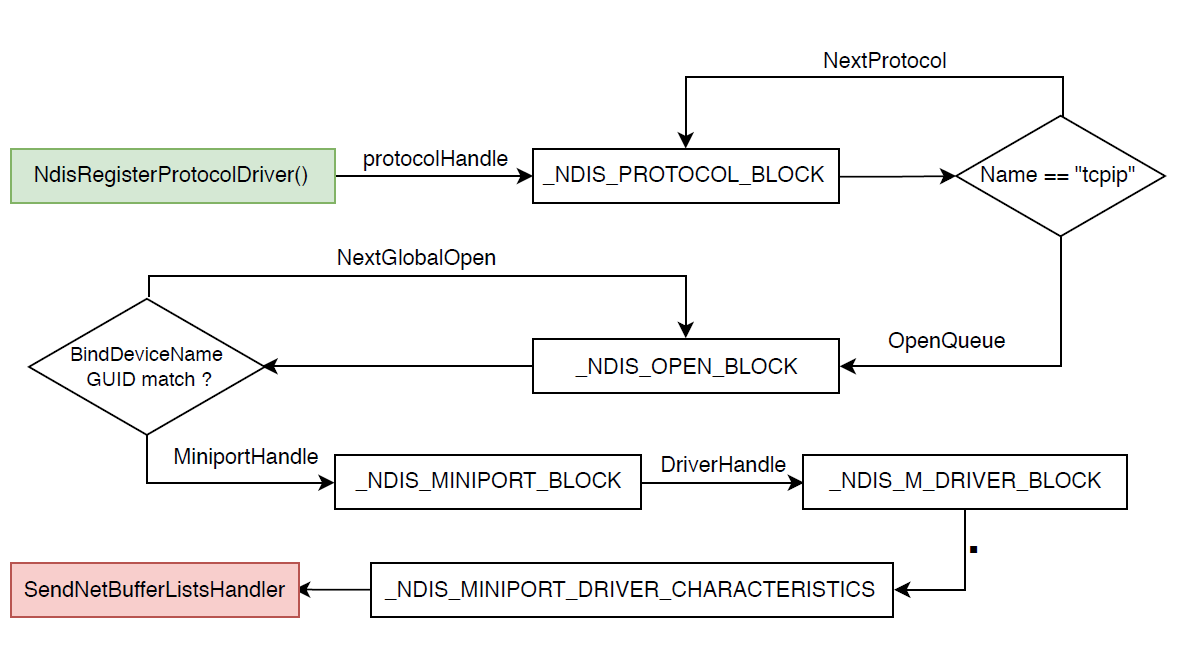LLNM is a proof of concept tool for detecting outgoing 'hidden' TCP network communication.
Modern rootkits try to hide its network communication from OS, firewalls and other security solutions.
This project was inspired by rootkit Pitou, which used NDIS hooks to conceal communication by sending network data directly to SendNetBufferLists function handler from module ndis.sys.
This function is responsible for direct communication with network card. Firewalls and monitoring tools working on higher levels in windows network stack thus are unable to detect anything suspicious.
LLNM is a tool built on the top of hypervisor DdiMon and uses its hidden
hooks (Kernel modification is forbidden - KPP, Attacker may check structures for hooks) to modify
SendHandler function in order to capture data which are sent from system.
Hook handler header (SendNetBufferLists):
static VOID HandleSendNetBufferLists(
_In_ NDIS_HANDLE NdisBindingHandle,
_In_ PNET_BUFFER_LIST NetBufferLists,
_In_ NDIS_PORT_NUMBER PortNumber,
_In_ ULONG SendFlags);
Important is structure NET_BUFFER_LIST which contains data that are going to be sent over the network. Data in this structure are parsed and IP address and PORT of hosts are retrieved.
See references for more information about _NET_BUFFER_LIST structure.
After retrieving IP and PORT of destination host, we check, whether system has information about this connection, since we are interested only in TCP. If OS does not track the connection, we can say, that packet is probably attempt to produce hidden malicious network traffic.
In user mode, checking of existing connection is easy, using WinAPI GetTcpTable2().
Since we work in Kernel mode, unfortunately there is not any API like this for drivers.
Combination of User mode application and Kernel mode driver would be very inefficient
because handler checks connection every time the OS sends out ethernet frame and
switching from Kernel mode to User mode would have big performance hit.
Therefore we had to reverse engineer Windows Internals to retrieve Information about existing TCP connections in the system by ourselves.
We explored function TcpEnumerateConnections() implemented in module tcpip.sys.
We analysed malware Pitou, Windows internals and used information from article about malware Srizbi.
Following picture describes way, how we obtain this address.
-
First We Use WinAPI NdisRegisterProtocolDriver() to install custom fake network protocol, which is absolutely useless.
We do this only to get access to chain of structures, representing installed protocols and this is the way, how to get to that chain.
After getting address of send handler, protocol is uninstalled.NDIS_STATUS NdisRegisterProtocolDriver( NDIS_HANDLE ProtocolDriverContext, PNDIS_PROTOCOL_DRIVER_CHARACTERISTICS ProtocolCharacteristics, PNDIS_HANDLE NdisProtocolHandle ); -
NdisProtocolHandle variable is in fact pointer to structure _NDIS_PROTOCOL_BLOCK which is set up by NDIS after installing protocol.
-
Iterate through structures until we get some protocol installed for TCPIP.
-
Using member OpenQueue we obtain structure _NDIS_OPEN_BLOCK which contains information about binding between protocol driver and miniport driver.
-
Next we check BindDeviceName member which contains String GUID of network adapter.
Since this project is Proof of concept, we do not monitor all network interfaces, but choose only one (the best Gateway), the same way as malware Pitou did.
Using WinAPI GetIpForwardTable2() we retrieve IP address of Default Gateway.
Then enumerate registry key [\Registry\Machine\SYSTEM\CurrentControlSet\Services\Tcpip\Parameters\Interfaces\]
and check value "DhcpDefaultGateway" against retrieved IP.
This way we obtain Network Interface GUID (key name of network adapter) which is then compared against BindDeviceName member. -
Finally through member MiniportHandle which is another pointer, we get to structure _NDIS_MINIPORT_BLOCK
and using member DriverHandle which is pointer as well we get _NDIS_M_DRIVER_BLOCK structure.
Substructure with name _NDIS_MINIPORT_DRIVER_CHARACTERISTICS contains member SendNetBufferListsHandler which is pointer to desired function.
Analysing function TcpEnumerateConnections() we've came to the following results:
Module tcpip.sys contains variables TCPIP_PARTITION_TABLE and TCPIP_PARTITION_PARTITION_COUNT pointers.
We rely on the fact, that these variables are at constant offsets within module tcpip.sys.
Structure TCPIP_PARTITION_TABLE contains pointer to Hash table, in which OS Windows stores information about TCP endpoints.
By enumerating this hash table we are able to verify, whether systems knows about specific connection or not.
bool CheckTcpipConnection(IN_ADDR* dstIP,USHORT port) {
RTL_DYNAMIC_HASH_TABLE_ENUMERATOR enumerator;
KLOCK_QUEUE_HANDLE LockHandle;
bool found = false;
// Get addresses of global variable in tcpip.sys based on fixed offsets
UCHAR ** partitionTablePtr = (UCHAR **)(tcpipBase + PARTITION_TABLE_PTR_OFFSET);
ULONG * partitionCount = (ULONG*)(tcpipBase + PARTITION_COUNT_OFFSET);
TCPIP_PARTITION_TABLE * partitionTable;
// Iterate through partitions
for (unsigned int i = 0; i < *partitionCount; i++) {
if (found) break;
partitionTable = (TCPIP_PARTITION_TABLE*)(((*partitionTablePtr) + NEXT_PARTITION_OFFSET*i));
KeAcquireInStackQueuedSpinLock(partitionTable->SpinLock, &LockHandle);
RtlInitWeakEnumerationHashTable(partitionTable->hashTable, &enumerator);
// Enumerate entries in hash table
while (1)
{
UCHAR* hEntry = (UCHAR*)RtlWeaklyEnumerateEntryHashTable(partitionTable->hashTable, &enumerator);
if (!hEntry) break;
TABLE_ENTRY* tableEntry = (TABLE_ENTRY*)(hEntry - HASH_TABLE_ENTRY_OFFSET);
IN_ADDR ip = *tableEntry->ipAddrStruct->ipAddr;
// Check entry match IP and port
if (ip.S_un.S_addr == dstIP->S_un.S_addr && tableEntry->remotePort == port) {
found = true;
break;
}
}
RtlEndWeakEnumerationHashTable(partitionTable->hashTable, &enumerator);
KeReleaseInStackQueuedSpinLock(&LockHandle);
}
return found;
}Here is a video showing LLNM in Action.
See description for DdiMon.
Use some driver loader to load LLNM
Use DebugView from SysInternals to watch kernel log
-
[1] FSecure: The “silent” resurrection of the notorious Srizbi kernel spambot
-
[2] Srizbi rootkit
-
[3] NDIS Structures _NET_BUFFER_XXX Structures NDIS Windbg NDIS Internal Structures
-
[4] TCP Endpoints http://www.robobrarian.info/b_pubs/CandSOkolica.pdf
-
[5] TCP Info Extraction https://pdfs.semanticscholar.org/4b33/508bb8aebd3e8b8d697e93f3164e801a011c.pdf
- x86 and x64 Windows 7
- Capturing network communication works on Windows 10, but detection is not
supported.
(didnt have time to reverse engineer structures of this OS version).
Layouts of TCPIP_PARTITION_TABLE, NDIS and other structures are not documented.
These structures are different among various os versions.
It is necessary to write different code for each version.
File "ndisStructs.h" contains structure definitions. For some os version, there may be whole structure definition with all structure members and for some, there are only important members and padding is used to match original structure.
Compilation is controlled by preprocessor variables _WIN64(set up by Visual Studio when choosing platform) and WIN7 which is necessary to setup manually in "ndisStructs.h"
Constants TABLE_ENTRY_PADDING0, TABLE_ENTRY_PADDING1 and 0x1ca are result of reverse engineering.
struct TABLE_ENTRY {
UCHAR padding0[TABLE_ENTRY_PADDING0];
IPADDR *ipAddrStruct;
PLIST_ENTRY ipInfoPtr;
UCHAR padding1[TABLE_ENTRY_PADDING1];
USHORT localPort;
USHORT remotePort;
UCHAR padding2[0x1ca];
ULONG* eprocess;
};
-
The system must support the Intel VT-x and EPT technology (DdiMon)
-
Use --recurse-submodules switch when cloning repo
